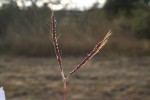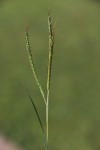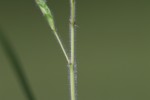| Home | > | List of families | > | Poaceae | > | Dichanthium | > | aristatum |
Dichanthium aristatum
Selected images: Click on each image to see a larger version and details of the record View all images (6)
Detailed records: Display species records QDS maps by: Google Maps Point records by Google Maps
Species details: Click on each item to see an explanation of that item (Note: opens a new window)
| Synonyms: |
Andropogon aristatus Poir. Andropogon caricosus subsp. mollicomus (Kunth) Hack. Andropogon mollicomus Kunth Andropogon nodosus (Willemet) Nash Dichanthium caricosum (L.) A. Camus var. mollicomus (Kunth) Haines Dichanthium nodosum Willemet Diplasanthum caricosum var. mollicomus (Kunth) Haines Diplasanthum lanosum Desv. Lepeocercis mollicoma (Kunth) Nees |
| Common names: | |
| Frequency: | |
| Status: | Introduced |
| Description: |
Tufted perennial with short stolons. Culms up to 1.1 m, robust; nodes exposed and glabrous. Inflorescence of 1-5, subdigitate, shortly pedunculate racemes; peduncles and culm below the inflorescence pubescent. Sessile spikelets: lower glume narrowly winged on the lateral keels, without tubercle-based cilia; lower floret barren; upper floret stipitiform, awn c. 22 mm long. Pedicelled spikelets similar in size and shape to the sessile spikelet, male or neuter. |
| Type location: |
|
| Notes: | |
| Derivation of specific name: | aristatum: bearing a long bristle-like point; aristate |
| Habitat: | In disturbed ground, roadside verges and grassy areas, often in damp places. |
| Altitude range: (metres) | |
| Flowering time: | |
| Worldwide distribution: | Native to India; introduced to Africa, Australia and America resulting from its usage as a fodder grass. |
| National distribution: | M |
| Growth form(s): | |
| Endemic status: | |
| Red data list status: | |
| Insects associated with this species: | |
| Spot characters: | Display spot characters for this species |
| Images last updated: | Tuesday 5 July 2016 |
| Literature: |
Cope, T.A. (2002). Poaceae Flora Zambesiaca 10(4) Pages 40 - 41. Mapaura, A. & Timberlake, J. (eds) (2004). A checklist of Zimbabwean vascular plants Southern African Botanical Diversity Network Report No. 33 Sabonet, Pretoria and Harare Page 102. Setshogo, M.P. (2000). Notes on the grass subtribe Sorghinae (Poaceae: Andropogoneae) in the Flora Zambesiaca area Kirkia 17(2) Page 143. |
Other sources of information about Dichanthium aristatum:
Our websites:
Flora of Zambia: Dichanthium aristatumFlora of Zimbabwe: Dichanthium aristatum
External websites:
African Plants: A Photo Guide (Senckenberg): Dichanthium aristatumAfrican Plant Database: Dichanthium aristatum
BHL (Biodiversity Heritage Library): Dichanthium aristatum
EOL (Encyclopedia of Life): Dichanthium aristatum
GBIF (Global Biodiversity Information Facility): Dichanthium aristatum
Google: Web - Images - Scholar
iNaturalist: Dichanthium aristatum
IPNI (International Plant Names Index): Dichanthium aristatum
JSTOR Plant Science: Dichanthium aristatum
Mansfeld World Database of Agricultural and Horticultural Crops: Dichanthium aristatum
Plants of the World Online: Dichanthium aristatum
Tropicos: Dichanthium aristatum
Wikipedia: Dichanthium aristatum
| Home | > | List of families | > | Poaceae | > | Dichanthium | > | aristatum |





